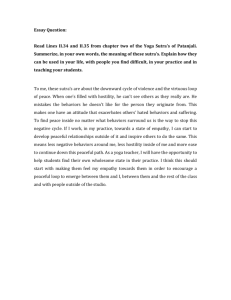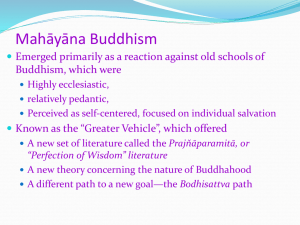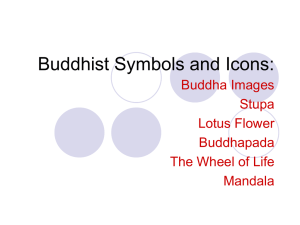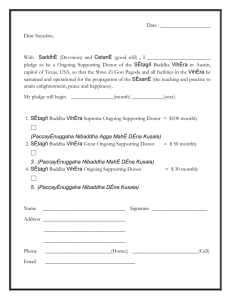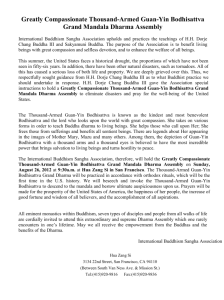Longevity and Health in the Tradition of the Lotus Sutra in China
advertisement
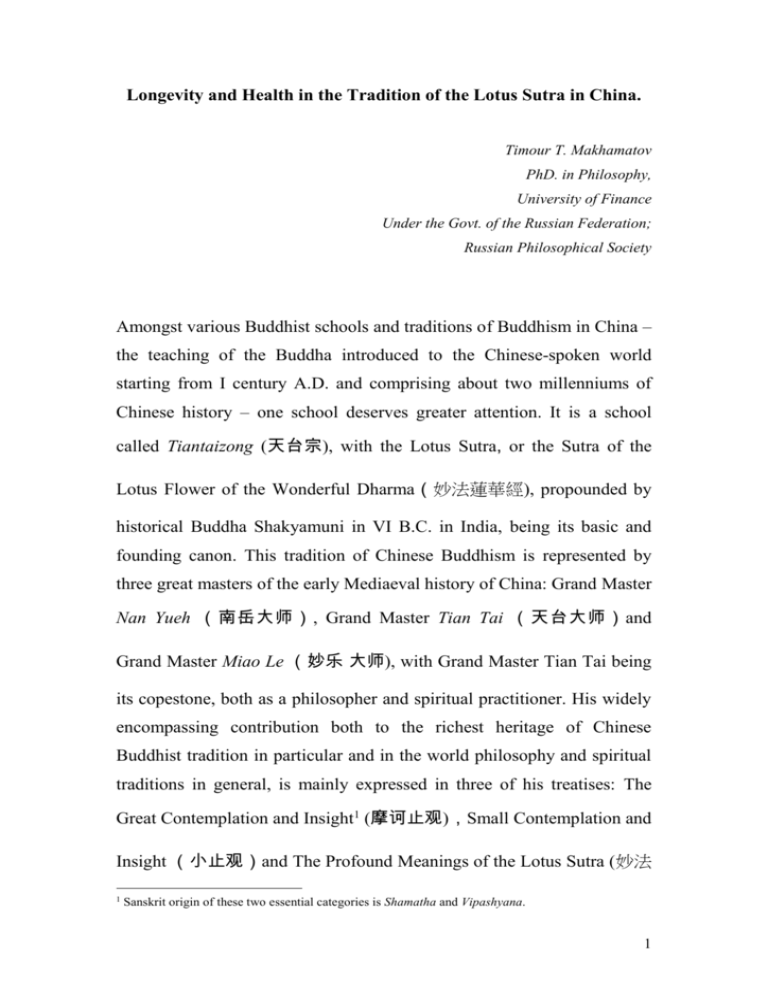
Longevity and Health in the Tradition of the Lotus Sutra in China. Timour T. Makhamatov PhD. in Philosophy, University of Finance Under the Govt. of the Russian Federation; Russian Philosophical Society Amongst various Buddhist schools and traditions of Buddhism in China – the teaching of the Buddha introduced to the Chinese-spoken world starting from I century A.D. and comprising about two millenniums of Chinese history – one school deserves greater attention. It is a school called Tiantaizong (天台宗), with the Lotus Sutra, or the Sutra of the Lotus Flower of the Wonderful Dharma(妙法蓮華經), propounded by historical Buddha Shakyamuni in VI B.C. in India, being its basic and founding canon. This tradition of Chinese Buddhism is represented by three great masters of the early Mediaeval history of China: Grand Master Nan Yueh (南岳大师), Grand Master Tian Tai (天台大师)and Grand Master Miao Le (妙乐 大师), with Grand Master Tian Tai being its copestone, both as a philosopher and spiritual practitioner. His widely encompassing contribution both to the richest heritage of Chinese Buddhist tradition in particular and in the world philosophy and spiritual traditions in general, is mainly expressed in three of his treatises: The Great Contemplation and Insight1 (摩诃止观),Small Contemplation and Insight (小止观)and The Profound Meanings of the Lotus Sutra (妙法 1 Sanskrit origin of these two essential categories is Shamatha and Vipashyana. 1 蓮 華 經 玄 義 ). The most expressive of all is his doctrine of Three Thousand ‘suchness’ 2 in One Moment of Thought ( 一 念 三 千 ) , disclosing the reality of each momentum of our thought, as comprising the entire infinity of the Being with its 10 realms of existence (the realms of hell, hungry spirits, animals, asuras, humans, heavenly creatures, arhats, pratyekabuddhas, bodhisattvas and the highest - the Realm of the Buddha), each containing, in turn, the same 10 layers of the world, at the same time possessing three aspects of existence attributed to each of the ten realms – environment, living beings inhabiting this environment, and their mind. The main idea expressed by Grand Master Tiantai, as derived from the Lotus Sutra, regarding the everlasting question of the longevity (寿) of a human being is that the longevity of an individual is closely related with that of the entire material existence, which is in itself beyond individuality. In the Lotus Sutra, it is in the most illustrative way demonstrated in chapter XI (“The Vision of the Precious Stupa“, 妙法 蓮華經观宝塔品第十一 ), when inside one Precious Stupa two Buddhas at once are residing side by side – Buddha Shakyamuni, representing the eternity and perfection of Spirit and Soul, and Tathagata Abundant Treasures (多宝如来)representing the eternity and immutability of material substance of the Universe, whereas the Precious Stupa symbolises eternal great Unity of the Universe. Thus, it is asserted that the entire material existence is eternal in its essence, being in great 2 如是 2 Oneness with spirit and space, whereas individual, particular objects representing this existence are impermanent and void. In this respect, Chapter XVI of the Lotus Sutra “The Duration of the Life of Tathagata” (妙法蓮華經如来寿量品第十六) is also considerably essential, expounding the core and most sacred teaching of the Buddha, disclosing the real span of his Life as being eternal, with no beginning and no end, being eternally caused by the Buddha’s profound practice of Bodhisattva. Buddha asserts that although the entire multitude of sentient beings witnesses his Great Extinction (Sanskr. - Mahaparinirvana), He ever dwells here, in this world, and never be extinct. And in this chapter of the Sutra, a term “Body of the Buddha” ( 佛 身 ) appears, that is eventually of crucial importance. Buddha is saying there: “Every momentum I ponder upon how to make living beings enter the No-End Path and promptly attain the Body of the Buddha”3 (得入无上道,速成 就 佛 身 ). Elaborating on this great teaching, Grand Master Tian Tai comments on the profound meaning of each of the five characters of the Chinese name of the Lotus Sutra, as expressing the entire profundity and power of the Dharma contained in the Sutra: 妙,法,蓮, 華 and 經, with the ninth Subtlety of the essential meaning of the first character - 妙 – the Subtlety of the Original Life-span – as indicating that “the Buddha’s original lifespan is ever lasting”4. This eventually leads to a conclusion Translated from the Russian edition: Сутра о Бесчисленных Значениях. Сутра о Цветке Лотоса Чудесной Дхармы. Сутра о Постижении Деяний и Дхармы Бодхисаттвы Всеобъемлющая Мудрость. / Изд. подгот. А.Н. Игнатович, В.В. Северская. 2-е изд., испр. и доп. – М.: Ладомир, 2007. С. 243. 4 Haiyan, Shen. “The Profound Meaning of the Lotus Sutra. T’ien-t’ai Philosophy of Buddhism”. Delhi, 2005. Vol. 1, P. 48. 3 3 that the lives of particular living creatures, with humans included, are generally nothing but the Life of the Eternal Buddha ever dwelling here in this world, that each separate life cannot be separated or considered apart from the eternal Life of the Buddha, from the immutable and indestructible Body of the Buddha. Is this not an inspiring reason for us all to appreciate our actual life and health and ever strive for attaining Harmony, Perfection and Wisdom?.. So, this entire world, the universe, is nothing but the Great Eternity, as revealed in the Lotus Sutra. Whereas throughout its history, humanity has been suffering greatly from numerous calamities, diseases, epidemics and mortality. What is the root of these innumerable and everlasting sufferings of human beings, and consequently, what should be the ultimate medicine to eliminate diseases and endow the humanity with the most precious gift of all – longevity? According to Grand Master Tian Tai 5 , there are a number of grave obstacles and hindrances standing on the way to longevity that dwell nowhere else but within our mind. These are various perversions, superstitions and preconceptions that are preconditioned by our individual karma created and accumulated since our own immeasurable past. Using Buddhist terminology, such obscurities of soul, heart and mind are perceived as demons and are called Mara. Now the question arises: is it at all possible to defeat, eliminate those maras, conquer them once and forever, thus purifying our six sensual channels (eyes, ears, nose, tongue, body and mind) and obtaining 5 As elaborated by prof. Shen Haiyan (沈海燕) in her substantial double-volume monograph named “The Profound Meaning of the Lotus Sutra. T’ien-t’ai Philosophy of Buddhism”. Delhi, 2005. 4 indestructible health and longevity? The answer is: yes. In our age it is possible through the challenging practice of Bodhisattva 6 (菩萨行) only that the entire hordes of Mara will eventually be defeated. In Chapter XX of the Lotus Sutra “Never Despising Bodhisattva”(常不軽 菩 薩 ) Buddha Shakyamuni is describing his own practice of this challenging Path in one of his previous lives – by expressing sincere reverence and worship to all people and other sentient beings surrounding him, predicting them to eventually become Buddhas. That practice is nothing but actually praying to the eternal Buddha-Nature (Sanskr. – Tathagatagarbha) inherent within everyone and everything, including ourselves. Thus, the Sutra maintains, through this practice, the profound aspiration for enlightenment possessed by one bodhisattva, may not only be cherished with others watching his practice, but also will inevitably lead to the great purification of the above-mentioned six ‘roots’ of life, planting the ‘seed’ of the enlightenment onto the soil of the ultimate reality of Eternal Life of the Buddha eternally inherent within ourselves. This teaching of the Buddha contained in the Threefold Lotus Sutra is called ‘Dharma of One Buddha-vehicle’ (一佛乘 ) and is revered to be the highest and most profound of all. In many parts of this Sutra Buddha is asserting that anyone who ever practises this Dharma of One Buddhavehicle will eventually purify his six ‘roots’ of life and will never be tortured by either of the five desires, anger, pride, arrogance, stupidity, jealousy, etc. In chapter XXIII of this Sutra “Previous Actions of Bodhisattva Medicine King” the following words are contained: “This Sutra is a good medicine against the diseases of the people of 6 Practice of Bodhisattva means to realise one's own aspiration for enlightenment and perfection through his care of others, thus infinitely and sincerely devoting oneself to serving others and the world. 5 Jambudvipa7. If an ill person can hear this Sutra, his indispositions will instantly disappear; he will escape aging and death.”8 In the third part of the Threefold Lotus Sutra – «The Sutra of the Activities and Dharma of Bodhisattva All-Encompassing Wisdom» (观世音菩薩 行法经), in which the six rules of the six 'roots' purification are explained, it is also said: «false notions cause the ocean of karmic hindrances. If anyone wishes to repent, let him sit straight and contemplate upon the 'sign' of true reality. Sins are similar to snow or hoarfrost and melt under the sun of wisdom. »9 In Chapter II “Expedient Means” of the Lotus Sutra(妙法蓮華經 方便 品第二) Buddha is expounding the teaching of “Ten Suchnesses” (十如 是)as being the basic and universal characteristics of all the realms of the entire existence. According to the Sutra, these ten ‘suchnesses’ are but the Wisdom of the Buddha itself, so by this Eye of all Buddhas the Buddha sees the world. What are these ‘suchnesses’? They are: “Suchness of appearance”, “Suchness of nature”, “Suchness of substance”, “Suchness of power”, “Suchness of function’, “Suchness of causes”, “Suchness of conditions”, “Suchness of effects”, “Suchness of retributions”, “Suchness of beginning-and-end-ultimately-alike” (meaning that the ‘appearance’ at the very beginning and the ‘retribution’ at the end are ultimately alike, and are converged into the same True 7 Ancient Sanskrit name of this world, typical for Buddhist scriptures. Translated from the Russian edition: Сутра о Бесчисленных Значениях. Сутра о Цветке Лотоса Чудесной Дхармы. Сутра о Постижении Деяний и Дхармы Бодхисаттвы Всеобъемлющая Мудрость. / Изд. подгот. А.Н. Игнатович, В.В. Северская. 2-е изд., испр. и доп. – М.: Ладомир, 2007. С. 281. 9 Ibid., c. 317-318. 8 6 Reality10). Here lies no difference between good and evil, as they are but one entity. As prof. Shen Haiyan expresses it, “the difference lies in the state between manifestation and concealment. Good and evil transform according to conditions, which is similar to the relationship between ice and water. This indicates that both aspects exist as the one entity of True reality, which arises in turn with causes and conditions.”11 According to traditional Chinese medicine, physical indispositions, both potentially existing and actually expressed, are directly correlated with our emotions, thoughts, feelings and life activities that are, in turn, according to Buddha’s teachings, predetermined by the complexity of our karma. According to Grand Master Tian Tai, “The correctly concentrated mind is capable of curing any disease”12. What does Grand Master mean by saying this? First of all, since the life of a separate human being is tightly related with the great infinity of nature, heaven and earth, space and universe, so are his misfortunes and indispositions, being nothing but a deeply penetrating reflection of his personal wrong-doings, perverted notions, disharmonious emotions and speech, both accumulated from his past lives and presently conducted, upon his present material body, so that our body bearing the entire complexity of its fortunes and misfortunes, including various physical capacities, general flow of energy and ultimately the potentiality of life span, can be well regarded as nothing but the mirror displaying the monitor of ourselves. In this respect, Grand Master Tian Tai teaches that judging from the present actual moment of life we are capable of knowing both our past and future, since both past and future simultaneously dwell in the present. Haiyan, Shen. “The Profound Meaning of the Lotus Sutra. T’ien-t’ai Philosophy of Buddhism”. Delhi, 2005. Vol. 2, P. 253. 11 Haiyan, Shen. “The Profound Meaning of the Lotus Sutra. T’ien-t’ai Philosophy of Buddhism”. Delhi, 2005. Vol. 2, P. 252. 10 12 Xiao Zhi Guan (小止观), Chapter IX 'Treating the Illness'. 7 Generally speaking, through the above-mentioned teaching of ten “Suchnesses”, disease and misfortune can be approached, along with the employment of Tian Tai’s universal method of Zhi and Guan (止观 ). So, according to Tian Tai, the method of treating diseases should be two-fold: 1. Cessation (止)of evil causes by contemplation upon our own mind, since the entire causation of all kinds of physical and mental disorder originates in our mind; and 2. Nourishment of good through proper concentration and insight (观) on the profound Truth of Emptiness and Impermanence, on the one hand, and omnipresent Eternal BuddhaNature, on the other. First of all, applying the principle of Zhi(止), a disease must be properly detected and recognised, with its causes clearly revealed. There are three general causes of diseases: 1. misbalance between the Four Great Elements (Earth, Water, Fire and Wind) and disorder of Five Depositories (Heart, Lungs, Liver, Pancreas and Kidneys); 2. Diseases caused by the interference of evil spirits; 3. Karmic diseases preconditioned from past lives. In order to detect a disease, one should first tranquilise and harmonise his emotions and mind, through seated meditation ( 坐 禅 ) and with the help of internal consciousness, expelling all kinds of empty thoughts and reminiscences from it. The nature of mind is similar to the nature of water: it is in the condition of calmness and stability only that the mind attains to transparency, thus being able to clearly observe its own depths. Then, the mind should be directed at the actual place of disorder. 8 Nextly, applying the second half of Tian Tai’s method, Guan (观), a proper method of treatment should be chosen, to eliminate the disorder. To contemplate on the mind and thoughts, using various specific ways of breathing – rigorous and subtle, quick and slow, upper and lower, warming up and cooling down, etc. – is a method prescribed for the first kind of diseases13. Reciting mantra and dharani can be regarded as the second method directed at the diseases caused by evil spirits, whereas karmic diseases should only be eliminated through sincere and profound self-purification by the repentance of wrongdoings committed in the past, followed by beneficial and charitable actions, such as donations to the Sangha or various kinds of support for the practice of the Buddha Dharma, as is explained in various Sutras. Thus, substantially speaking, the entire mind and soul should be enlightened by our innate power of bodhisattva as the internal cause, in the coherence with the power of the Dharma, as the external condition, with our darkness and fundamental ignorance elucidated and our individual ‘self’ preconditioned by our karma finally becoming in harmony and inseparable unity with the whole nature, universe and eternal wisdom. This is an ultimate cause for our individual life to naturally become one with the eternal life of great Cosmos, by itself obtaining the virtue (德) of Longevity (寿). More elaborate teaching on this subject can be found in Xiao Zhi Guan (小止观), Chapter IX 'Treating the Illness' (in any appropriate edition). 13 9

